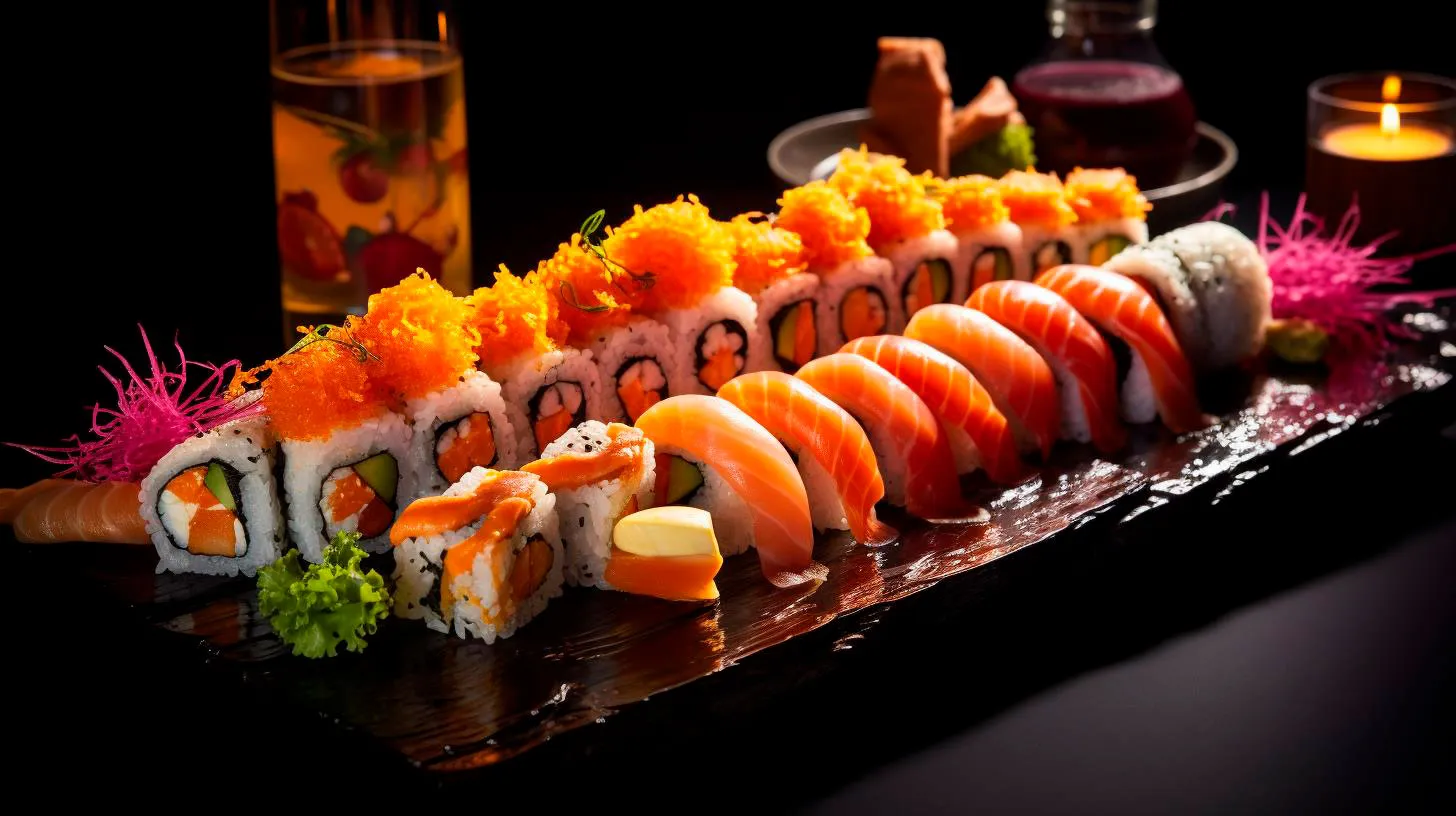Essential Steps for Maintaining the Longevity of Your Sushi Knife
In this article, we will explore essential steps to help you take care of your valuable sushi knife, ensuring it remains sharp, safe, and durable for years to come.
The Importance of Proper Maintenance
Before diving into the specific steps, it’s essential to understand why proper maintenance is so crucial for your sushi knife. Here are some key reasons:
- Longevity: Proper maintenance practices can significantly extend the lifespan of your sushi knife, saving you money in the long run.
- Performance: Regular maintenance ensures your knife remains sharp, allowing you to effortlessly slice through delicate fish without damaging the texture or presentation.
- Hygiene: By keeping your knife clean and sanitary, you reduce the risk of food contamination and maintain a safe kitchen environment.
Step 1: Cleaning Your Sushi Knife
The first step in maintaining your sushi knife is to clean it thoroughly after each use. Here’s how:
- Gently hand-wash: Avoid putting your knife in the dishwasher, as harsh detergents and high temperatures can damage the blade. Instead, carefully hand-wash your knife with mild soap and warm water.
- Use a non-abrasive sponge: Scrub the blade gently using a soft sponge or cloth. Avoid using abrasive cleaners or scrub brushes that can scratch the surface.
- Dry it immediately: After washing, dry the knife with a clean towel to prevent any moisture that can lead to rust or corrosion.
Step 2: Sharpening Your Sushi Knife
To ensure your sushi knife remains sharp and performs optimally, regular sharpening is necessary. Here are some tips for sharpening your knife:
- Invest in a whetstone: Purchase a high-quality whetstone to maintain the sharpness of your blade. It is recommended to use a coarse-grit stone for initial sharpening and a finer-grit stone for polishing.
- Follow the correct technique: Properly hold the knife and maintain a consistent angle while sharpening. Begin with light strokes and gradually increase the pressure for desired sharpness.
- Test the sharpness: After sharpening, carefully touch the blade to a sheet of paper. If it slices through effortlessly, your knife is sufficiently sharpened.
Step 3: Storing Your Sushi Knife
Safe storage plays a vital role in maintaining the longevity of your sushi knife. Follow these guidelines when storing your knife:
- Use a knife sheath or wooden saya: Protect the blade by storing it in a knife sheath or a wooden saya when not in use. These safeguards prevent accidental damage and maintain the knife’s sharpness.
- Avoid overcrowding: Store your sushi knife separately from other utensils to prevent them from knocking against each other and causing potential damage.
- Keep it dry: Before storing your knife, ensure it is completely dry. Moisture can lead to rust and corrosion, compromising the durability and performance of your knife.
Key Takeaways
Maintaining your sushi knife requires proper cleaning, sharpening, and storage practices. Here are the key takeaways to remember:
- Regularly clean your sushi knife by hand with mild soap and warm water, avoiding the dishwasher.
- Invest in a high-quality whetstone and sharpen your knife regularly at the correct angle.
- Protect your knife with a sheath or saya when not in use to prevent accidental damage.
- Avoid overcrowding and keep your knife dry to prevent rust and corrosion.
By following these essential steps, you can ensure that your sushi knife remains in top condition, allowing you to prepare delicious sushi with precision and ease.
Proper Cleaning Techniques for Sushi Knives
To ensure the longevity and performance of your sushi knives, proper cleaning techniques are essential. In this article, we will explore the best practices for cleaning your sushi knives, providing you with the knowledge you need to maintain their sharpness and effectiveness.
Why Properly Cleaning Sushi Knives Matters
Before diving into cleaning techniques, let’s briefly discuss why it is important to clean your sushi knives properly. Sushi knives are typically made from high-quality stainless steel or carbon steel. While these materials offer excellent cutting performance, they are prone to rust and corrosion if not properly maintained. By taking care of your knives, you can prevent damage, maintain their sharpness, and extend their lifespan.
Essential Cleaning Steps
Follow these essential cleaning steps to ensure your sushi knives remain in top condition:
1. Rinse Immediately After Use
After using your sushi knives, it is crucial to rinse them under running water immediately. This helps remove any leftover food particles and prevents them from adhering to the blade, which can lead to corrosion. Be sure to rinse both sides of the knife thoroughly.
2. Hand Wash with Mild Detergent
Using a gentle dishwashing detergent, hand wash your sushi knives with warm water. Avoid using abrasive scrubbers or brushes that could scratch the blade’s surface. Instead, use a soft sponge or cloth to clean the knife, paying close attention to the blade’s edge.
3. Dry Thoroughly
After washing, thoroughly dry the knife with a soft towel or cloth. Ensure all moisture is removed, as even the smallest amount can cause rust or corrosion. Pay special attention to the knife’s handle and the area where the blade meets the handle, as water can accumulate in these areas.
4. Apply Food-Grade Mineral Oil
Once the knife is completely dry, apply a thin layer of food-grade mineral oil to the blade. This helps prevent rust and corrosion, acting as a protective barrier. Be sure to wipe off any excess oil to prevent oily residue from transferring onto your food.
5. Store Properly
Proper storage is crucial to maintain the longevity of your sushi knives. Avoid storing them in damp or humid environments, as this can promote rust formation. Consider investing in a knife block or a blade protector to keep your knives safe and secure when not in use.
Key Takeaways
- Properly cleaning sushi knives is essential to prevent rust and maintain performance.
- Rinse the knives under running water immediately after use to remove food particles.
- Hand wash with mild detergent, avoiding abrasive scrubbers that could damage the blade.
- Thoroughly dry the knives to prevent moisture accumulation.
- Apply a thin layer of food-grade mineral oil to protect against rust.
- Store the knives in a dry environment and consider using a knife block or blade protector.
By following these proper cleaning techniques, you can ensure that your sushi knives remain in pristine condition, allowing you to create beautiful and delicious sushi for years to come. Remember, maintaining the sharpness and cleanliness of your knives is crucial not only for the quality of your sushi but also for your own safety. So, embrace these cleaning practices and elevate your sushi-making experience!
Practical Tips to Keep Your Sushi Knife Razor-Sharp
In this article, we will explore some practical tips that will help you maintain the razor-sharpness of your sushi knife, ensuring every sushi-making session is a delightful experience.
1. Choose the Right Sushi Knife
Before diving into maintenance techniques, it’s crucial to invest in a high-quality sushi knife. Japanese knives, like the traditional Yanagiba or the versatile Santoku knife, are known for their precision and sharpness. Look for knives made from high-carbon stainless steel, as they provide excellent edge retention.
- Invest in a high-quality Japanese sushi knife for precision slicing.
- Choose blades made from high-carbon stainless steel for enhanced performance.
2. Proper Handling and Storage
Proper handling and storage can greatly impact the longevity of your sushi knife’s sharpness.
- Never use your sushi knife on hard surfaces like glass or ceramic as it can dull the blade.
- Always hand wash and dry your knife immediately after use to prevent corrosion.
- Store your knife in a knife block or protective sheath to avoid accidental damage or dulling.
3. Regular Honing
Honing your sushi knife regularly helps to maintain its sharpness and alignment of the blade.
- Invest in a honing rod specifically designed for Japanese knives.
- Hone your knife before or after each use to realign the blade and maintain its sharpness.
4. Sharpening your Sushi Knife
While honing helps to maintain the blade’s sharpness, regular sharpening is necessary to re-establish a keen edge on the knife.
- Use a high-quality whetstone to sharpen your sushi knife.
- Follow the manufacturer’s guidelines or seek professional assistance for proper sharpening techniques.
- Practice patience and maintain a consistent angle while sharpening to ensure an even edge.
5. Professional Maintenance
Although regular honing and sharpening can be done at home, professional maintenance can significantly extend the lifespan of your sushi knife.
- Consider professional maintenance services to recondition and restore your knife’s sharpness.
- Professional sharpening restores the blade’s original sharpness and ensures overall performance.
Key Takeaways
A razor-sharp sushi knife is essential for achieving perfect slices of sushi. Here are the key takeaways from this article:
- Invest in a high-quality sushi knife made from high-carbon stainless steel.
- Handle and store your knife with care, avoiding hard surfaces and ensuring it is always clean and dry.
- Hone your knife regularly to maintain its edge alignment.
- Sharpen your sushi knife when necessary using a high-quality whetstone and proper techniques.
- Consider professional maintenance for extending your knife’s lifespan.
By following these practical tips, you can ensure that your sushi knife remains razor-sharp, allowing you to create beautiful and appetizing sushi at home. Enjoy the process of slicing through each roll with precision and savor the incredible flavors of your homemade sushi!


